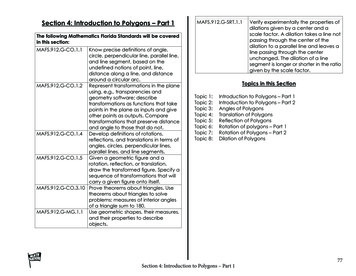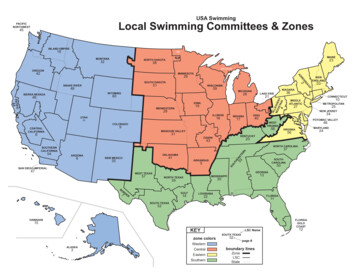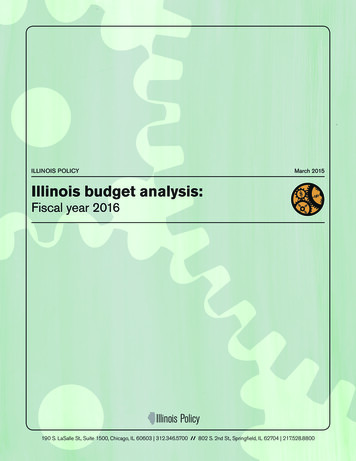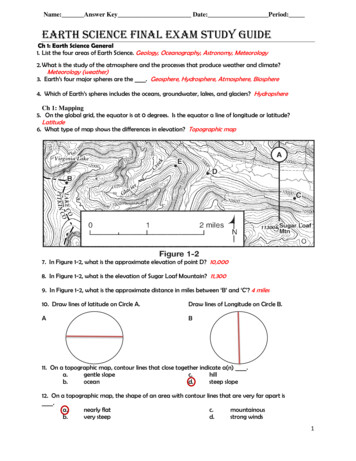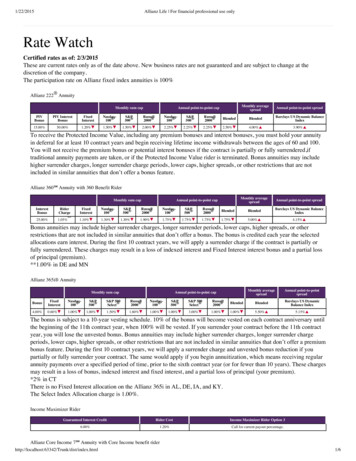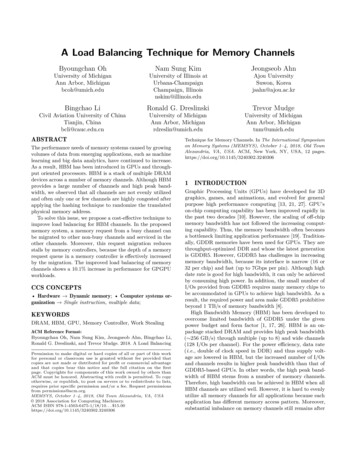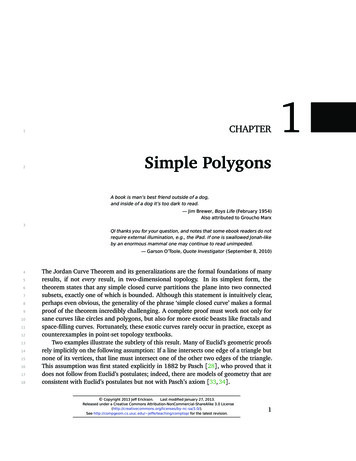
Transcription
CHAPTER12Simple PolygonsA book is man’s best friend outside of a dog,and inside of a dog it’s too dark to read.— Jim Brewer, Boys Life (February 1954)Also attributed to Groucho Marx3QI thanks you for your question, and notes that some ebook readers do notrequire external illumination, e.g., the iPad. If one is swallowed Jonah-likeby an enormous mammal one may continue to read unimpeded.— Garson O’Toole, Quote Investigator (September 8, 2010)456789101112131415161718The Jordan Curve Theorem and its generalizations are the formal foundations of manyresults, if not every result, in two-dimensional topology. In its simplest form, thetheorem states that any simple closed curve partitions the plane into two connectedsubsets, exactly one of which is bounded. Although this statement is intuitively clear,perhaps even obvious, the generality of the phrase ‘simple closed curve’ makes a formalproof of the theorem incredibly challenging. A complete proof must work not only forsane curves like circles and polygons, but also for more exotic beasts like fractals andspace-filling curves. Fortunately, these exotic curves rarely occur in practice, except ascounterexamples in point-set topology textbooks.Two examples illustrate the subtlety of this result. Many of Euclid’s geometric proofsrely implicitly on the following assumption: If a line intersects one edge of a triangle butnone of its vertices, that line must intersect one of the other two edges of the triangle.This assumption was first stated explicitly in 1882 by Pasch [28], who proved that itdoes not follow from Euclid’s postulates; indeed, there are models of geometry that areconsistent with Euclid’s postulates but not with Pasch’s axiom [33, 34]. Copyright 2013 Jeff Erickson.Last modified January 27, 2013.Released under a Creative Commons Attribution-NonCommercial-ShareAlike 3.0 sa/3.0/).See http://compgeom.cs.uiuc.edu/ jeffe/teaching/comptop/ for the latest revision.11
1. SIMPLE POLYGONSpathendpointsimpleTo avoid excessiveformalityclosed curvecycleS1simplepath-connectedcomponentpolygonal chainvertex!of a polygonalchainedge!of a polygonalchainA stronger version of the Jordan curve theorem states that the bounded componentof the complement of a simple closed curve is simply connected, which means intuitivelythat it has no holes. As a second example of the subtlety of the Jordan curve theorem,consider the following plausible converse: The boundary of every simply-connected planarregion is a simple closed curve. Readers are invited to think of their own counterexamplesto this claim before turning to the end of the chapter.A full proof of the Jordan Curve Theorem requires machinery that will appear onlylater in the book (specifically, homology). In this chapter we consider only one importantspecial case: simple polygons. Polygons are by far the most common type of closedcurve employed in practice, so this special case has immediate practical consequences.Most textbook proofs of the full Jordan Curve Theorem both dismiss this special caseas trivial and rely on it as a key lemma. Indeed, the proof is ultimately elementary;nevertheless, its formal proof was the origin of several fundamental algorithmic tools incomputational geometry and topology.11.1A Few DefinitionsWe begin by carefully defining the terms of the theorem.A path in the plane is an arbitrary continuous function π: [0, 1] R2 , where [0, 1]is the unit interval on the real line. The points π(0) and π(1) are called the endpointsof π; we say informally that π is a path from π(0) to π(1). A path π is simple if it isinjective. To avoid excessive formality, we do not normally distinguish between a simplepath (formally a function) and its image (a subset of the plane).A closed curve (or cycle) in the plane is a continuous function from the unit circleS1 : {(x, y) R2 x 2 y 2 1} into X . A cycle is simple if it is injective. As for paths,we do not normally distinguish between a simple cycle and its image.A subset X of the plane is (path-)connected if there is a path from any point in X toany other point in X . A (path-connected) component of X is a maximal path-connectedsubset of X .The Jordan Curve Theorem. The complement R2 \ C of any simple closed curve C in theplane has exactly two components.A polygonal chain is a finite sequence of line segments p0 p1 , p1 p2 , . . . , pn 1 pn joining adjacent pairs in a finite sequence of points p0 , p1 , . . . , pn in the plane. The points piare the vertices of the polygonal chain, and the segments pi 1 pi are its edges. Withoutloss of generality, we assume that no pair of consecutive edges is collinear; in particular,consecutive vertices are distinct.Any polygonal chain describes a piecewise-linear path in the plane. Specifically, forany polygonal chain P of vertices p0 , p1 , . . . , pn , there is a unique path π P : [0, 1] R2such that for any index i, the restriction of π P to the interval [i/n, (i 1)/n] is a 2728293031323334353637
1.1. A Few Definitions123456789101112131415161718map to the line segment pi pi 1 :π p (t) (nt mod 1)pdnte ((1 nt) mod 1)pbntcTo avoid excessive formality, we rarely distinguish between a polygonal chain P (asequence of line segments), the corresponding path π P (a function into the plane).A polygonal chain is closed if it has at least one edge and its first and last verticescoincide (that is, if p0 pn ) and open otherwise. Closed polygonal chains are alsocalled polygons; a polygon with n vertices and n edges is also called an n-gon. Anyclosed polygonal chain describes (or less formally, is) a closed curve in the plane.A polygonal chain is simple if its vertices are distinct (except possibly p0 pn )and its edges intersect only at endpoints, or equivalently, if the corresponding path orcycle is simple. To avoid excessive formality, we usually do not distinguish betweena simple polygonal chain (formally a sequence of line segments) and the union of itsedges (a subset of the plane). Every simple polygon has at least three edges.To avoid excessiveformalitypolygonal chain!closedpolygonal chain!openpolygonn-gonsimpleTo avoid excessiveformalityThe Jordan Polygon Theorem. The complement R2 \ P of any simple polygon P in theplane has exactly two components.The phrase ‘simple polygon’ is more commonly used to describe the closed regionbounded by a simple closed polygonal chain, but as we have not yet proved the Jordanpolygon theorem, we don’t actually know that such a region always exists!A simple 10000-gon.23
1. SIMPLE POLYGONS1.2slabtrapezoidfloorceilingwallProving the Jordan Polygon TheoremOur proof of the Jordan polygon theorem very roughly follows an argument by Schönflies [12,29]. Fix an arbitrary simple polygon P with vertices p0 , p1 , . . . , pn 1 . To simplifythe proof, we assume without loss of generality that no two vertices pi and p j lie on thesame vertical line; if we rotate P around any fixed point, there are only a finite numberof orientations that violate this assumption, so we can always choose one that doesn’t.For each index i, let i be the vertical line through vertex pi . These n vertical linessubdivide the plane into n 1 slabs, two of which are actually halfplanes. The edgesof P further subdivide each slab into a finite number of trapezoids. Some trapezoidsare unbounded in one or more directions, and others actually triangles.12345678910Vertical lines through the vertices of a simple polygon.One slab and five trapezoids are shaded.The boundary of each trapezoid consists of at most four line segments: the floorand ceiling, which are segments of polygon edges, and the left and right walls, whichare (possibly infinite) segments of vertical lines i whose endpoints (if any) lie on thepolygon. Formally, we define each trapezoid to include its walls but not its floor, itsceiling, or any vertex on its walls. Thus, each trapezoid is connected, any two trapezoidsintersect in a common wall or not at all, and the union of all the trapezoids is R2 \ P. Ourproof assigns labels to each trapezoid in two different ways, which ultimately correspondto “inside P” and “outside P”.Lemma 2. R2 \ P has at most two components.Proof: Consider each edge pi pi 1 of the P to be directed from pi to pi 1 . We label eachtrapezoid either left or right, depending on which side of the polygon the trapezoidappears. More formally, we label a trapezoid left if it satisfies at least one of the followingconditions: The ceiling is directed from right to left.41112131415161718192021222324
1.2. Proving the Jordan Polygon Theorem12345678 The floor is directed from left to right. The right wall contains a vertex pi , and the incoming edge pi 1 pi is below theoutgoing edge pi pi 1 . The left wall contains a vertex pi , and the incoming edge pi 1 pi is above theoutgoing edge pi pi 1 .These conditions apply verbatim to unbounded trapezoids and to trapezoids that areactually triangles. There are four symmetric conditions for labeling a trapezoid right.Every trapezoid is labeled left or right or possibly both.LLLL?LLRLLLLLLLR?LLLLeft trapezoids.23Now we define a cyclic sequence of left trapezoids by traversing the polygon andlisting the trapezoids we see to our left, as suggested by the arrows in the figure above.We start the traversal at vertex p0 with the empty sequence of trapezoids. As we traverseeach edge pi pi 1 directed to the right (resp. to the left), we add all the trapezoids justabove (resp. below) that edge to the sequence, in order from left to right (resp. rightto left). When we traverse a vertex pi whose neighbors pi 1 and pi 1 are both tothe right of pi , and the incoming edge pi 1 pi is above the outgoing edge pi pi 1 , weadd the trapezoid just to the left of pi to the sequence. Similarly, when we traverse aright-extreme vertex where the polygon turns right, we add the trapezoid just to its rightto the sequence. The resulting sequence of trapezoids contains every left trapezoid atleast once (and at most four times); moreover, any adjacent pair of trapezoids in thissequence share a wall and thus have a connected union. It follows that the union of theleft trapezoids is connected.A symmetric argument implies that the union of the right trapezoids is also connected, which completes the proof. 24Lemma 2. R2 \ P has at least two components.910111213141516171819202122252627Proof (Jordan): Label each trapezoid even or odd depending on the parity of thenumber of polygon edges directly above the trapezoid. Thus, within each slab, thehighest trapezoid is even, and the trapezoids alternate between even and odd.5
1. SIMPLE POLYGONSorientation!triple ofpoints in the planeConsider two trapezoids A and B that share a common wall, with A on the left and Bon the right; suppose the wall lies on the vertical line i . If the vertices pi 1 and pi 1are on opposite sides of i , exactly the same number of polygon edges are above A andabove B. Suppose pi 1 and pi 1 lie to the left of i . If the point pi lies below the wallA B, then A and B are below the same number of edges; otherwise, A is below twomore edges than B. Similar cases arise when pi 1 and pi 1 lie to the right of i . In allcases, A and B have the same parity.It follows by induction that any two trapezoids in the same component of R2 \ Phave the same parity, which completes the proof. The Jordan Polygon Theorem follows immediately from Lemmas 2 and 2.Our proofs of these lemmas apply more generally closed curves that have a finitenumber of left- and right-extrema and a finite number of intersections with any verticalline—for example, any closed curve composed of a finite number of polynomial paths.However, considerably more work is required to handle arbitrary closed curves.3The two lemmas actually rely on complementary properties of closed curves in theplane. Lemma 2 is still true if we replace the plane with any other topological surface.On the other hand, our proof of Lemma 2 applies nearly verbatim if we replace Pwith any set of (not necessarily simple) polygons; the only change is that we must alsodraw vertical lines through intersection points.1.3Point in Polygon Test1 q.x (q, r, s) : det 1 r.x1 s.x q. y r. y s. y (r.x q.x)(s. y q. y) (r. y q. y)(s.x q.x).The triple (q, r, s) is oriented counterclockwise if (q, r, s) 0 and oriented clockwise if (q, r, s) 0. If (q, r, s) 0, the three points are collinear. The orientation of a triple634567891011121314151617181920It is straightforward to convert the proof of Lemma 2 into the standard algorithmto test whether a point is inside a simple polygon in the plane in linear time: Shootan arbitrary ray from the query point, count the number of times this ray crosses thepolygon, and return TRUE if and only if this number is odd. This algorithm has beenrediscovered several times, but the earliest published description seems to be a 1962paper of Shimrat [31] (later corrected by Hacker [13]).To make the ray-parity algorithm concrete, we need one numerical primitive fromcomputational geometry. A triple (q, r, s) of points in the plane is oriented counterclockwise if walking from q to r and then to s requires a left turn, or oriented clockwise ifthe walk requires a right turn. More formally, consider the 3 3 determinant 12212223242526272829303132333435
1.4. Triangulations123456789of points in unchanged by any cyclic permutation, but reversed by swapping any twopoints.Finally, here is the algorithm. The input polygon P is represented by an array ofconsecutive vertices, which are assumed to be distinct. The algorithm returns 1, 1,or 0 to indicate that the query point q lies inside, outside, or directly on P, respectively.The function call ONORBELOW(q, r, s) returns 1 if q lies directly below the segment rs,returns 0 if q lies on rs, and returns 1 otherwise. To correctly handle degenerate cases,ONORBELOW treats any polygon vertex on the vertical line through q as though it wereslightly to the left. The algorithm clearly runs in O(n) time.POINTINPOLYGON(P[0 . n 1], q):sign 1P[n] P[0]for i 0 to n 1sign sign · ONORBELOW(q, P[i], P[i 1])return sign101112131415161.4ONORBELOW(q, r, s):if r.x s.xswap r sif (q.x s.x) or (q.x r.x)return 1return sgn( (q, r, s))TriangulationsMost algorithms that operate on simple polygons do not only store the sequence ofvertices and edges, but also a decomposition of the polygon into simple pieces thatare easier to manage. In the most natural decomposition, the pieces are triangles thatmeet edge-to-edge. More formally, a triangulation is a triple of sets (V, E, T ) with thefollowing properties.17 V is a finite set of points in the plane, called vertices.18 E is a set of interior-disjoint line segments, called edges, between points in V .20 T is a set of interior-disjoint triangles, called faces, whose vertices are in V andwhose edges are in E.21 Every point in V is a vertex of at least one triangle in T .22 Every segment in E is an edge of at least one triangle in T .1926If in addition the union of the triangles in T is the closure of the interior of a simplepolygon P, we call (V, E, T ) a triangulationS of P. More generally, we call any triangulation (V, E, T ) a triangulation of the set T . These definitions have several immediateconsequences, whose proofs we leave as exercises for the reader.27Lemma 1.3. Let (V, E, T ) be any triangulation of any simple polygon P.28(a) Every vertex of P is also a vertex of .29(b) Every edge of P is the union of vertices and edges of .232425303132triangulation!in theplanevertex!of a polygontriangulationedge!of a polygontriangulationface!of a polygontriangulationtriangulation!of apolygonexercises for the reader(c) Every segment in E is an edge of either one triangle or two triangles in T .(d) The intersection of any two triangles in T is either an edge of both triangles, a vertexof both triangles, or the empty set.7
1. SIMPLE POLYGONSfrugal triangulationdiagonalearWe call a polygon triangulation frugal if the vertices of the triangulation are preciselythe vertices of P. A diagonal of a simple polygon P is a line segment whose endpoints arevertices of P and otherwise lies in the interior of P. Every edge of a frugal triangulationis either an edge of the polygon or a diagonal. We emphasize that our definitions oftriangulations and diagonals require the Jordan polygon theorem.12345From left to right: A frugal triangulation, a non-frugal triangulation, and a non-triangulation.After playing with a few examples, it may seem obvious that every simple polygonhas a frugal triangulation, but a formal proof of this fact is surprisingly subtle.4Lemma 1.4 (Dehn [9], Lennes [23]). Every simple polygon with at least four verticeshas a diagonal.Proof: Let q be the rightmost vertex of P, and let p and r be the vertices immediatelybefore and after q in order around P.First suppose the segment pr does not otherwise intersect P. For any point x in theinterior of pr, the ray from x through q crosses P exactly once, at the point q. (TheJordan triangle theorem implies that P does not intersect the interior of the the segmentxq, or more generally the interior of the triangle 4pqr. Similarly, the ray from q leadingdirectly away from x does not intersect P, because q is the leftmost vertex of P.) Itfollows that pr lies in the interior of P and thus is a diagonal. In this case, we call 4pqran ear of P.6789101112131415161718rqspThe leftmost vertex is the tip of an ear. The rightmost vertex is not.Otherwise, P intersects the interior of pr. In this case, the Jordan triangle theoremimplies that 4pqr contains at least one vertex of P in its interior. Let s the rightmost81920
1.4. Triangulations1234567891011vertex in the interior of 4pqr. (In fact, we can take s to be any vertex in the interior of4pqr such that some line through s separates q from all other vertices in the interior of4pqr.) The line segment qs lies in the interior of P and thus is a diagonal. One can verifymechanicallyTheorem 1.5 (Dehn [9], Lennes [23]). Every simple polygon with n vertices has a frugal triangulation.Proof: The result follows by induction from the previous lemma. Let P be a simplepolygon with n vertices p0 , p1 , p2 , . . . , pn 1 . If n 3, then P is a triangle, and thus hasa trivial triangulation. Otherwise, suppose without loss of generality (reindexing thevertices if necessary) that p0 pi is a diagonal of P, for some index i. Let P and P denote the polygons with vertices p0 , pi , pi 1 , . . . , pn 1 and p0 , p1 , p2 , . . . , pi , respectively.The definition of diagonal implies that both P and P are simple.Recursively triangulating a polygon.1213141516171819202122232425262728Consider an arbitrary point p in the interior of P but not on the diagonal p0 pi ,and an arbitrary ray R from p that does not intersect p1 pi . The definition of ‘interior’implies that R crosses the boundary of P an odd number of times. Thus, either R crossesthe boundary of P an odd number of times and crosses the boundary of P an evennumber of times, or vice versa. We conclude that every point in the interior of P is eitherin the interior of P , in the interior of P , or on the diagonal p0 pi .The inductive hypothesis implies that P has a frugal triangulation (V , E , T )and that P has a frugal triangulation (V , E , T ). One can verify mechanically that(V V , E E , T T ) is a frugal triangulation of P. Corollary 1.6 (Dehn [9], Meisters [25]). Every simple polygon with at least four vertices has an ear.Proof: We prove the following stronger claim by induction: Every simple polygon withat least four vertices has two ears that do not share an edge. Fix a simple polygon P withat least four vertices, and let pq be a diagonal of P. Following the proof of Theorem 1.5,splitting P along pq yields two simple polygons P and P . If P is a triangle, its twoedges other than pq define an ear of P. Otherwise, the inductive hypothesis impliesthat P has two ears that do not share an edge. At most one of these ears uses the9
1. SIMPLE POLYGONSexercises for the readertrapezoidaldecompositionedge pq, so at least one is also an ear of P. In either case, we conclude that P containsan ear of P. A symmetric argument implies that P contains an ear of P. These two earshave no edge in common. 123Recursively finding finding two disjoint ears.We leave the following additional observations as exercises for the reader, hint, hint.4Lemma 1.7. Every frugal triangulation of a simple n-gon has exactly n 2 facets andexactly n 3 edges.6Lemma 1.8. Let P be a simple polygon with vertices p0 , p1 , . . . , pn 1 . Let i, j, k, l be fourdistinct indices with i j and k l, such that both pi p j and pk pl are diagonals of P.These two diagonals cross if and only if either i k j l or k i l j.Lemma 1.9. Any maximal set of non-crossing diagonals in a simple polygon P is theedge-set of a frugal triangulation of P.1.5Constructing a TriangulationThe proof of Lemma 1.4 implies an algorithm to find a diagonal in a simple polygonswith n vertices in O(n) time. By applying this algorithm recursively, we can computea triangulation of any simple n-gon in O(n2 ) time. We can dramatically improve thisalgorithm by taking a more global view; consider the following alternative proof ofLemma 1.4.Fix a simple polygon P with vertices p0 , p1 , . . . , pn 1 for some n 4; as usual, weassume without loss of generality that no two vertices of P lie on a common verticalline. We begin by subdividing the closed interior of P into trapezoids with verticalline segments through the vertices. Specifically, for each vertex pi , we cut along thelongest vertical segment through pi in the closed interior of P. The resulting subdivision,which is called a trapezoidal decomposition of P, can also be obtained from the slabdecomposition we used to prove the Jordan polygon theorem, by removing every exteriorwall and every wall that does not end at a vertex of P.10578910111213141516171819202122232425
1.5. Constructing a Triangulationmonotone mountainconvexexercise for the readerA trapezoidal decomposition of a simple polygon.123456We can identify fifteen different types of trapezoids, depending on whether the leftand right walls have a vertex at the ceiling, have a vertex at the floor, have a vertex inthe interior, or consist entirely of a vertex. (There are fifteen types instead of sixteenbecause at least one of the walls of a trapezoid is not a single point.) In nine of thesefifteen cases, the line segment between the two vertices on the boundary of the trapezoidlies entirely in the interior of the trapezoid and thus is a diagonal of P.Fifteen types of trapezoids, nine of which contain diagonals789101112131415161718If none of those nine types of trapezoids occur in the decomposition, then eitherevery trapezoid has both vertices on the ceiling, or every vertex has both vertices on thefloor. Then P is a special type of polygon called a monotone mountain: any verticalline crosses at most two edges of P, and the leftmost and rightmost vertices of P areconnected by a single edge.Without loss of generality, suppose p0 is the leftmost vertex, pn 1 is the rightmostvertex, and every other vertex is above the edge p0 pn 1 (so all trapezoids have bothvertices on the ceiling). Call a vertex pi convex if the interior angle at that vertex is lessthan π, or equivalently, if the triple (pi 1 , pi , pi 1 ) is oriented clockwise. Let pi be anyconvex vertex other than p0 and p1 ; for example, take the vertex furthest above theline p0 p 1 . Then the line segment pi 1 pi 1 is a diagonal; we leave the proof of this finalclaim as an exercise for the reader.11
1. SIMPLE POLYGONShomeomorphismhomeomorphicA monotone mountain and four of its diagonals.This completes our second proof of Lemma 1.4. · Construct trapezoidal decomposition in O(n log n) time by plane sweep. Also citerandomized incremental construction. Sketch only; a full description requires datastructures introduced in the next chapter. See Chapter 3 for existing sketch. · Given a trapezoidal decomposition of P, we can construct a frugal triangulation of Pin O(n) time using the proof of Lemma 1.4 as follows. First, we identify all trapezoids inthe decomposition that contain a diagonal. These diagonals partition the polygon into aset of monotone mountains, some or all of which may be triangles. Then we triangulateeach monotone mountain by repeatedly cutting off convex vertices, using the followingalgorithm. · · 234567Three-penny algorithm. Leave as exercise?1.6The Jordan-Schönflies TheoremNow we consider the following very useful extension of the Jordan curve theorem,attributed to Arthur Schönflies [30]. A homeomorphism is a continuous function whoseinverse is also continuous. Two spaces are homeomorphic if there is a homeomorphismfrom one to the other. For example, a simple closed curve can be defined as any subsetof the plane homeomorphic to the circle S 1 .The Jordan-Schönflies Theorem. For any simple closed curve C in the plane, there is ahomeomorphism from the plane to itself that maps C to the unit circle S 1 .This theorem implies not only that R2 \ C has two components, but also that C isthe boundary of both components, and that the closure of the bounded component ishomeomorphic to the unit disk B 2 : {(x, y) R2 x 2 y 2 1}. Again, these resultsseem obvious at first glance, but the natural three-dimensional generalization of theJordan-Schönflies theorem is actually false.Like the Jordan curve theorem, a full proof of the Jordan-Schönflies theorem requiresmore advanced tools; we will prove only the special case where C is a simple polygon. Infact, this is the only case that Schönflies [30] actually proved, and a proof of this specialcase already appears in Dehn’s unpublished manuscript [9]. The proofs presented in12189101112131415161718192021222324
1.6. The Jordan-Schönflies Theorem123456789101112this chapter (including the triangulation results in the previous section) are modeledafter Dehn’s arguments, but with several further simplifications.The Dehn-Schönflies Polygon Theorem. For any simple polygon P in the plane, thereis a homeomorphism from the plane to itself that maps P to the boundary of a triangle.Proof (Dehn [9]): We prove the theorem by induction. Fix a simple polygon P withvertices p0 , p1 , . . . , pn 1 . If P is a triangle, the theorem is trivial, so assume that n 4.Without loss of generality, suppose p1 is the tip of an ear of P. Let P 0 denotethe polygon with vertices p0 , p2 , p3 , . . . , pn 1 ; the definition of ‘ear’ implies that P 0 issimple. The induction hypothesis implies that there is a homeomorphism φ 0 : R2 R2that maps P 0 to the boundary of a triangle. Thus, it suffices to prove that there is aa homeomorphism ψ: R2 R2 that maps P to P 0 ; the composition φ φ 0 ψ is ahomeomorphism of the plane that maps P to the boundary of a triangle.qp0qp1p2p0rmp2rShrinking an ear.131415161718192021222324252627282930We construct a suitable piecewise-affine homeomorphism ψ as illustrated in thefigure above. Let q be a point close to p1 but outside P; let m be the midpoint of thediagonal p0 p2 ; and let r be a point close to m, just outside the triangle 4p0 p1 p2 . Finally,let Q denote the closed convex quadrilateral with vertices p0 , q, p2 , r. We have twodifferent but combinatorially isomorphic triangulations of Q, one with internal vertex p1 ,the other with internal vertex m. Let ψ to be the unique piecewise-affine map thatmaps the first triangulation of Q to the second. That is, we set ψ(x) to the identityoutside the interior of Q; we set ψ(p1 ) m; and then we linearly extend ψ across thetriangles 4p0 p1 q, 4qp1 p2 , 4p2 p1 r, and 4r p1 p0 . It is routine to verify that ψ is indeeda homeomorphism. For many applications of this theorem, the following weaker version is actuallysufficient.Theorem 1.10. The closure of the interior of any simple polygon is homeomorphic to atriangle.Proof: Let P be a simple polygon with n vertices p1 , p2 , . . . , pn , and let Q be a convexn-gon with vertices q1 , q2 , . . . , qn . We first proving that the closed interior of P ishomeomorphic to the closed interior of Q, and then prove that the the closed interiorof Q is homeomorphic to a triangle.13
1. SIMPLE POLYGONSLet (V, E, T ) be any frugal triangulation of P, and let (V 0 , E 0 , T 0 ) be the triple obtainedfrom (V, E, T ) by replacing each point pi with the corresponding point qi . That is,qi q j E 0 if and only if pi p j E, and 4qi q j qk T 0 if and only if 4pi p j pk T . Convexityimplies that any line segment between non-adjacent vertices of Q is a diagonal of Q.Moreover, Lemma 1.8 implies that for any pair pi p j and pk pl of noncrossing diagonalsof P, the corresponding diagonals qi q j and qk ql of Q are also noncrossing. It followsthat (V 0 , E 0 , T 0 ) is a frugal triangulation of Q.1234567Any triangulation of a simple polygon is isomorphic to a triangulation of a regular polygon.Now let φ be the piecewise-linear map from the closed interior of P to the closedinterior of Q that maps each vertex pi onto the corresponding vertex q j , and moreovermaps each triangle pi p j pk in T affinely onto the corresponding triangle qi q j qk in T 0 . Itis straightforward to check that φ is a homeomorphism.Finally, consider a new triangulation of Q obtained by adding diagonals from qnto every other vertex except qn 1 and q1 . As in the previous paragraph, we can easilyconstruct a piecewise-linear homeomorphism from this triangulation to a (non-frugal)triangulation of any triangle, with one edge of the triangle subdivided into n 2 smallercollinear segments. Transforming a regular polygon into a triangle.148910111213141516
1.7. Generalizations of Polygons123456789101112131415
1.2. Proving the Jordan Polygon Theorem 1 The floor is directed from left to right. 2 The right wall contains a vertex pi, and the incoming edge pi 1pi is below the 3 outgoing edge pipi 1. 4 The left wall contains a vertex pi, and the incoming edge pi 1pi is above the 5 outgoing edge pipi 1. 6 These conditions apply verbatim to unbounded trapezoids and to trapezoids that are


